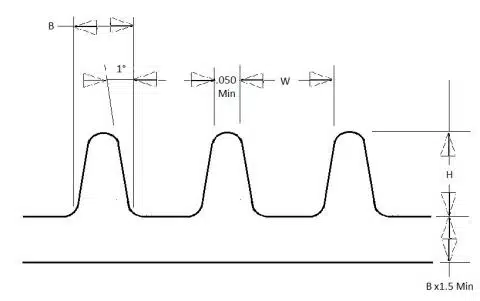
Slots and fins are common features that appear often on Investment Cast parts and typical of configuration that can be incorporated into a design with minimal impact on the cost. There are, however, some basic rules-of-thumb for the design of slots and grooves to help keep them from becoming cost drivers.
Let’s begin with a simple Slot that is open on both ends. (A slot that is closed at both ends is essentially a Blind Pocket. See the blog posting about blind holes and pockets.) The wider the slot the greater the depth to which it can be cast. This is because it is necessary for investment casting to build a minimum number layers of ceramic shell in or about a feature to produce it. When the ratio of slot width to depth becomes too tight the ceramic will not form properly and will fail when metal is cast. For example a .040” wide slot can be cast to only a depth of .040”, whereas a .100” wide slot can be cast to a .200” depth.
There is a table in The O’Fallon Casting Investment Casting Design Guide that delineates the ratio for various sizes of castable slots. The Design Guide that is available for free download on the O’Fallon Casting website.
It is also essential that slots have a fillet radius at their bottom. OFC recommends a Minimum fillet of .060”R. Smaller slots should be designed with a full radius at the base.
Fins are most often employed on a casting to act as heat sinks but they might also be decorative. Fins are essentially slots that are stacked back to back so the basic design rules for the Width::Depth ratio and fillet radii of a slot apply also to fins.
Thin fins can be difficult to fill with metal and are “vulnerable” features on a casting that can be easily damaged. To enhance both their castability and structural strength it is best to design fins .05” wide at the top with 1° of taper per side so that they are thicker at the base. (This also increases the cooling surface area of the fin.)
The fin to fin spacing should be according to the Slot Table in the Design Guide and derived from the height of the fin and by applying the .05” width at the top and the 1° taper per side. The same as with slots as taller fins will also need to be spaced further apart.
When the fin height, depth and thickness is properly designed the major foundry issue is of feeding sufficient hot metal to the fins so that they will fill. It helps to the feed the fins if they are mounted upon a wall that is 1.5x – 2x the thickness of the fins.
However, a designer must also provide the foundry also with sufficient gating surfaces to feed all of that metal. It will sometimes be necessary, particularly within large fin patterns, to provide “Gate Pads” within the field of fins. A gate pad might be a ½” x 1” rectangle that fills the entire volume from the top of the fins to the floor. The residual gate pads will then reside as a cosmetic features on the finished part. It is important to discuss the need for gate pads with the foundry prior to the “ink drying” on a new design.
A question often asked is whether fin should be round or flat at the top? Rounded fin tops are preferable from a foundry perspective. Flat topped fins have sharp edges along the sides of the flat that can be detrimental to the foundry process. A foundry will need to “break” the sharp edges along the length of the fins so designs for a flat topped fin should include an allowance for a .02R Max tolerance along the edges. Before making a decision, consult your foundry as to the best shape of fin top for your design.
It is important to understand that when any isolated mass solidifies on one side of a wall it will create a minor concavity in the opposing wall opposite to the mass. This is particularly noticeable on castings of thin wall thicknesses. Cast fins will create small indents that run linearly along the wall opposite the fins. These depressions might be only a few thousandths of an inch in depth, scarcely noticeable in the as-cast condition, but might be a cosmetically unappealing feature especially when coated with a high gloss finish. A foundry does have some process options that can help to mitigate these “sinks” but cannot totally circumvent this natural condition.
Slots and Fins when designed properly are very castable features and shouldn’t excessively drive the cost for the casting. Is always good practice to confirm their castability with a foundry and to determine if any Gate Pads need to be incorporated into their design.
If you have any questions about designing cast slots and fins contact your O’Fallon Casting Sales Engineer.
